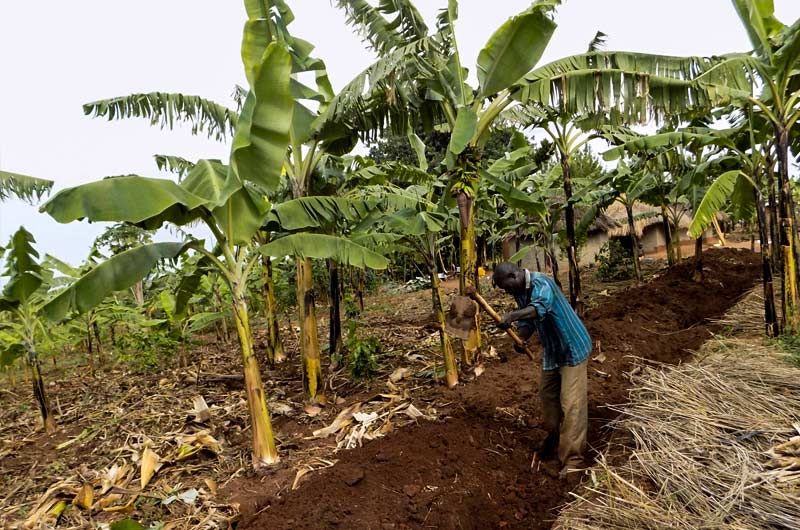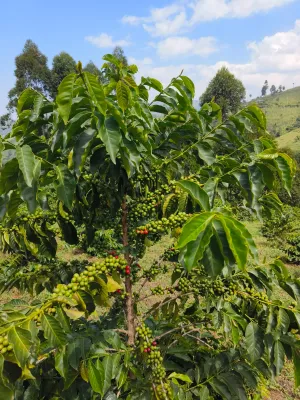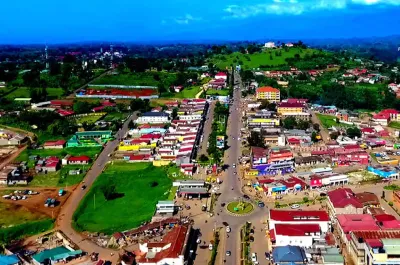

Digging trenches on a small scale farm
There are simple ways through which you can manage ground water flow to increase productivity on your farm.
A diversion ditch is a leveled canal excavated across a water way to intercept surface water running down a slope and divert it to a safe outlet or to derive other uses from it on a farm. The structure can be in the form of a trench, a narrow base channel or a hillside ditch.
Cut-off drains are canals built to collect runoff from land surface upstream and divert the water safely to a particular route or river. Cut-off drains thus protect the land or infrastructure downstream from excessive erosion. Most of the common ditches or trenches are constructed using earth materials and can be lined with rock fragments (stone pitching), concrete or other material depending on the available resources and needs.
Retention ditches are constructed off water ways to trap and store the excess run-off on the slopes that would otherwise be detrimental downstream. Unlike diversion ditches, retention ditches have closed ends to enable storage of water. Retention or diversion ditches are commonly known as mutalo or mufuregye in our local languages. They are commonly applied in the hilly and mountainous parts of Uganda especially the Rwenzori, Kigezi and Elgon sub-regions.
Major advantages of using ditches
They reduce the speed of run-off that would otherwise damage properties downstream.
They minimise the potential of washing away of top soil and nutrients from the bare fields.
They mitigate against the impacts of soil erosion that include making big gullies across fields that make mechanisation difficult.
Water collection channels also store excess water to be used on the farm during times of water scarcity.
Diversion channels require little or no technical knowledge to be constructed.
They can be constructed using locally available tools and materials including earth soil, pick axe, pangas, hand hoes among others.
Collection ditches can be used as breeding ground for aquatic species including fish.
The water collected in the ditches promotes and supports the ecosystem by providing livelihood for other living organisms including frogs.
Diversion channels enable reclamation and use of previously unproductive and steep land used for production.
Collection channels increase the soil water infiltration rates by holding the water longer.
The soil that is excavated from trenching of the channels can be mixed with unproductive soil to improve soil fertility hence improving crop production.
Embankments of trenches are planted with grasses, legumes and trees stabilising soils and enhancing vegetative growth leading to both biomass and soil carbon conservation.
The moisture availability increases the microbial activity in the soil hence improving soil fertility.
Retention ditches also act as drainage points for excess water from the water saturated or water-logged fields.
Retention ditches enable mechanisation of the fields by draining any excess water that would otherwise make field movements of machinery more difficult.
The volume of work involved in making retention ditches is far less than that of terraces.
Retention ditches also reduce leaching of field nutrients since they prevent soil erosion.
Tips for farmers using collection channels
Simple excavations should not be wider than 45 cm – 1.0 m, higher than 0.5m with embankments of 50 to 60 cm for ease of construction with locally available skills.
Complicated construction of ditches or trenches should be avoided since these are quite costly due to heavy machinery and technical inputs required.
Simple ditches or trenches enable access of the field machinery for mechanisation.
Trenches should be 10-20 m long depending on the steepness of the field and run-off volumes. The distances should be 10m for land with slopes between 30-20%, about 20m for slopes of 20-12% and 30m for slopes of less than 12%.
Vegetation such as Napier grass, Paspalum are grown on the trench banks or embankments to stabilise them.
Periodic maintenance and manual drudging of the trenches are necessary to remove silt or sediments trash or maintain the initial layout.
Trees and vegetation with strong (tap) root systems should be avoided closer to the ditches since they tend to crack the banks or embankments hence weakening and deforming the structure.
The banks should be constructed at a slope to stabilise the structure and avoid eventual collapse.
The channel bed should be leveled with a slope to enable free flow of water from one end of the channel to another.
The retention trenches should be isolated from poultry, other livestock and children to avoid the collected/diverted water being a death trap.
To avoid it from being a breeding ground for harmful disease-transmitting vectors, retention ditches should be monitored and treated where possible.
To increase water infiltration and even distribution, tie bunds (intact blocks of soils) could be left at intervals of 45 cm to 60 cm within each trench.
The writer is an agricultural engineer. okothrujema@gmail.com














Joseph Okoth
Leave a Comment
Your email address will not be published.